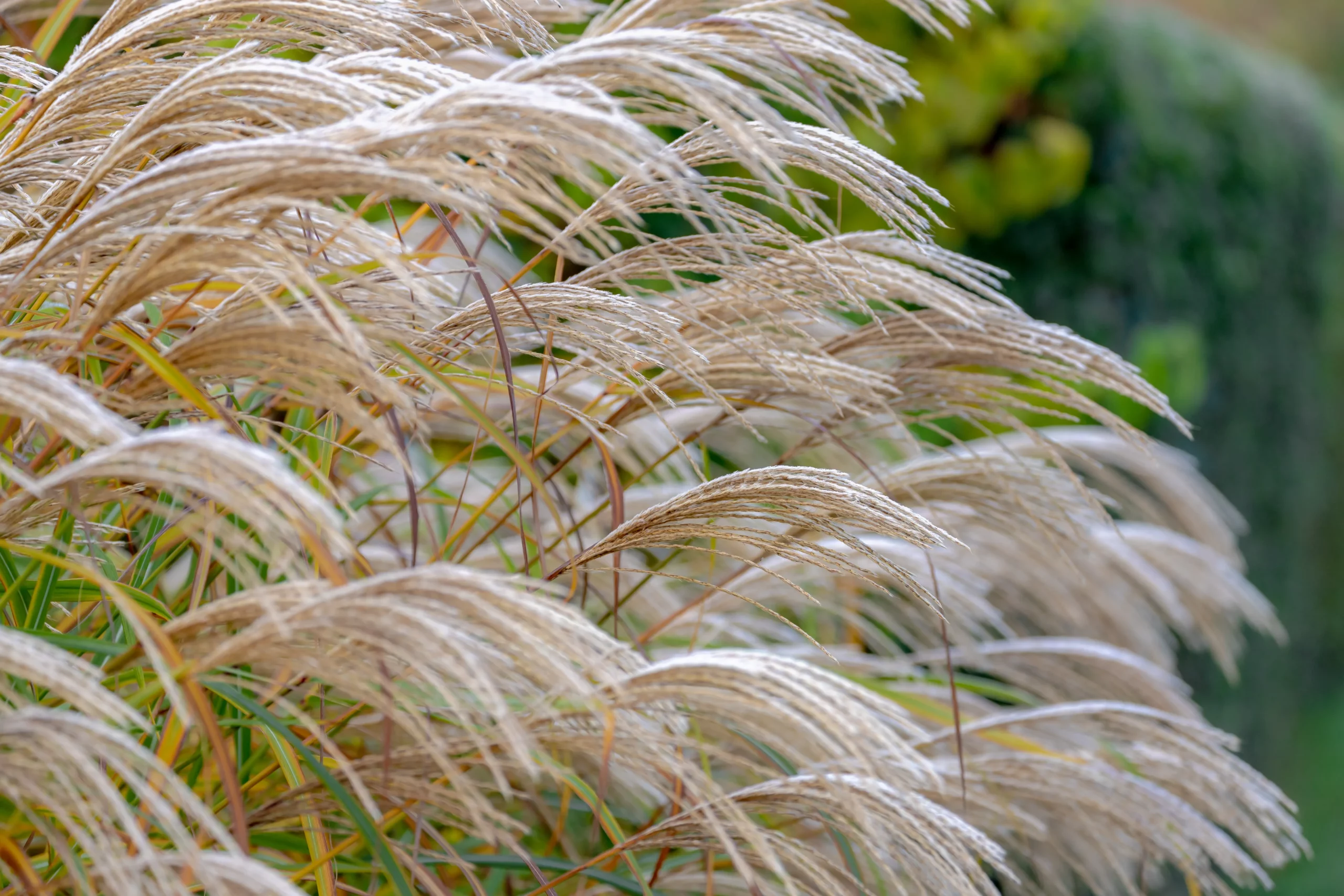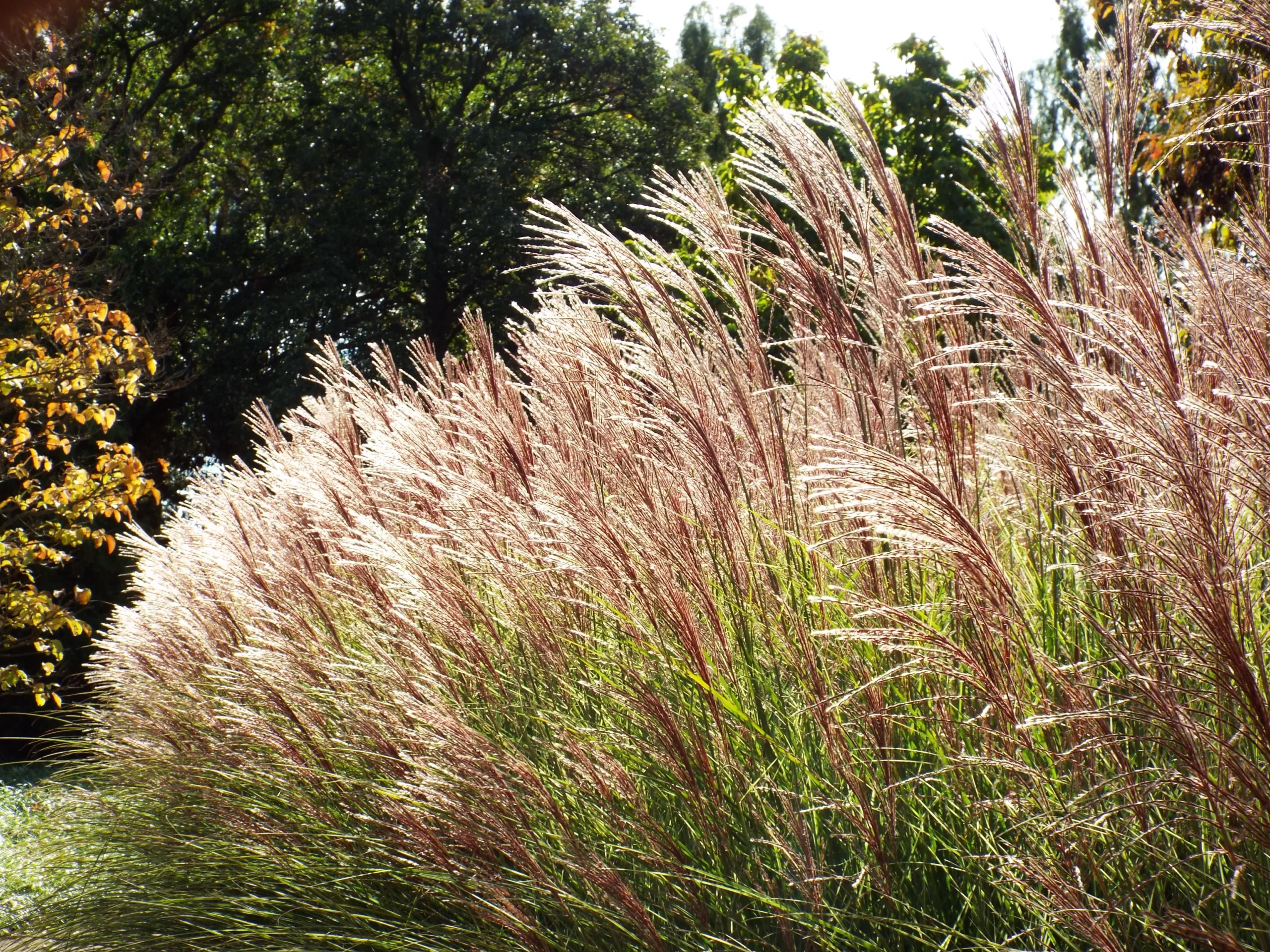Family: Maiden Grass
Type: Ornamental Grass
Other Common Name: Japanese Silver Grass

Maiden Grass (Miscanthus sinensis) is a graceful, ornamental grass known for its tall, slender stature and feathery plumes that sway beautifully in the breeze. This versatile plant adds texture, movement, and elegance to any landscape, reaching heights of up to 6 feet or more. Its narrow leaves turn from green to golden as the seasons change, providing year-round interest.
Adaptable and hardy, Maiden Grass thrives in a variety of conditions but prefers full sun to achieve its best growth. It is drought-tolerant once established, making it a low-maintenance option for gardeners seeking long-lasting beauty with minimal care. The plant’s striking appearance is complemented by its ability to serve as a privacy screen, windbreak, or focal point in the garden.
Maiden Grass’s silky tassels emerge in late summer and persist through the fall, transitioning from pink to silver as they mature. This plant not only enhances garden aesthetics but also attracts birds and provides habitat for wildlife, enriching the biodiversity of outdoor spaces. Whether used in mass plantings or as a solitary specimen, Maiden Grass is a standout addition that brings a touch of the wild to domestic landscapes.
Hardiness Zone: 4a-9b
Pet Friendly: Yes
Moisture Preference: Average to moist
Sun Needs: Full sun to partial shade
Growth Rate: Medium
Average Height (feet): 6
Average Spread (feet): 4
Average Life Span (years): 20
Form: Upright spreading
Flower Color: Pink
Bloom Season: From late summer to early fall
Foliage Color: Green
Leaf Fall Color: Brown
Foliage Shape: Grassy
Incorporating Maiden Grass into your yard can transform the landscape into a dynamic and visually appealing space. Planting it along borders or fences creates a natural barrier that adds privacy while allowing light and air to filter through. Its tall, waving fronds bring a sense of movement and life to the garden, especially when placed where they can catch the light or breeze.
Pairing Maiden Grass with broad-leaved perennials or shrubs offers a contrast in textures that can make each plant stand out more distinctly. The slender leaves and feathery plumes of Maiden Grass complement the solid forms of plants like hydrangeas or peonies, creating a layered and lush garden design that appeals to the senses.
For a modern, minimalist garden, Maiden Grass can serve as a striking architectural element. Its upright growth and elegant silhouette provide structure and style to contemporary landscapes. Using it in groups or as a stand-alone feature in gravel gardens or against hardscapes highlights its sculptural quality and adds sophistication to the garden’s overall look.

Maiden Grass fits seamlessly into Asian or Zen garden designs, where its natural grace and simplicity can be appreciated. Its flowing form echoes the tranquility and balance sought in these gardens, making it a perfect choice.
In a prairie garden, Maiden Grass contributes to the wild, natural aesthetic, blending beautifully with native wildflowers and grasses. Its height and movement mimic the open, untamed spaces of the prairie.
For coastal gardens, Maiden Grass is ideal due to its tolerance for wind and salt spray. Its resilience and flowing form evoke the seaside landscape, adding both beauty and function as it helps to stabilize soil.
Create a serene backyard retreat by using Maiden Grass as a backdrop for a garden seating area. Its rustling sound in the breeze adds a calming ambiance, while its height provides a sense of seclusion.
Design a dynamic entryway by planting Maiden Grass on either side of a walkway. This guides visitors toward the entrance with a graceful, waving motion that changes with the seasons, welcoming guests with natural elegance.
Use Maiden Grass in a rain garden where its adaptability to wet conditions can be advantageous. It adds height and interest to these functional spaces, enhancing their appearance while contributing to environmental sustainability.
Select our pre-made garden layouts to create a landscape that’s uniquely yours. Simple, smart, and customizable!
In spring, Maiden Grass begins to show new growth, emerging from the ground with fresh green shoots that signal the return of life to the garden after winter.
By summer, Maiden Grass reaches its full height, providing a lush, green backdrop for summer blooms. This is when it begins to form its distinctive plumes, adding texture and interest.
Fall sees Maiden Grass at its peak, with plumes maturing to a striking silver that catches the light beautifully. The foliage turns golden, offering a warm, autumnal hue to the landscape.
In winter, Maiden Grass remains attractive, with dried fronds and plumes standing tall above the snow. This provides structure and interest in the garden during the dormant season, as well as shelter for wildlife.
Pinus mugo var. pumilio
Ophiopogon japonicus 'Nanus'
Buxus microphylla japonica 'Wintergreen'
Maiden Grass thrives in an area that receives full sun to partial shade. It prefers a spot where it can bask in the sunlight for most of the day to develop its full potential.
Full sun is ideal for Maiden Grass, ensuring the most vigorous growth and best plume production. It can tolerate partial shade, but its growth may not be as robust.
This grass is adaptable to a wide range of soil types but prefers well-drained soil. It can tolerate some clay and sandy soil conditions if there is adequate drainage.
Space Maiden Grass plants about 4-6 feet apart to give them room to spread and allow for adequate air circulation between plants.
The best time to plant Maiden Grass is in the spring after the last frost or in early fall, giving it time to establish before winter.
Dig a hole twice as wide and just as deep as the root ball. Position the grass in the center, fill the hole with soil, tamp down gently, water thoroughly, and apply mulch around the base to retain moisture.
Water Maiden Grass regularly during its first growing season to help establish a deep, extensive root system. Once established, it is quite drought-tolerant but benefits from occasional watering during prolonged dry spells.
Apply a general-purpose fertilizer lightly in the spring to encourage new growth. Maiden Grass does not require heavy fertilization.
Cut back Maiden Grass to a few inches above the ground in late winter or early spring before new growth begins. This helps to keep the plant looking tidy and encourages healthy, vigorous growth.
Remove any winter debris and cut back the previous year's growth. Apply a layer of mulch and a light fertilizer to support new growth.
Ensure the plant receives adequate water, especially during hot, dry periods. Maiden Grass is relatively low-maintenance in the summer.
Maiden Grass can be left standing to provide winter interest and habitat for wildlife. Apply a protective layer of mulch if desired.
No active care is needed. The dried foliage and plumes offer visual interest and should be pruned back in late winter.
Calamagrostis x Acutiflora 'Karl Foerster'
Panicum virgatum 'Northwind'
Miscanthus sinensis 'Morning Light'
Maiden Grass grows quickly once established, reaching its full height and spread within one to two growing seasons.
Some varieties of Miscanthus sinensis can be invasive in certain regions. It’s always best to check with local extension services or gardening groups to ensure you are planting a non-invasive variety.
Yes, Maiden Grass can be divided in early spring every few years to rejuvenate the plant and propagate new plants. Division helps maintain the health and vigor of the grass.
Sign up below to get exclusive deals, discounts, and new plant collections—delivered straight to your inbox! Plus, stay inspired with the latest gardening tips, landscaping trends, and DIY garden ideas. Start growing with us today!
A big thank you for subscribing to the PBN Design newsletter.
We're thrilled to have you join our community. Get ready for exciting updates, insightful content, and more delivered straight to your inbox.
Stay tuned!
Go backA big thank you for subscribing to the PBN Design newsletter.
We're thrilled to have you join our community. Get ready for exciting updates, insightful content, and more delivered straight to your inbox.
Stay tuned!
Go back